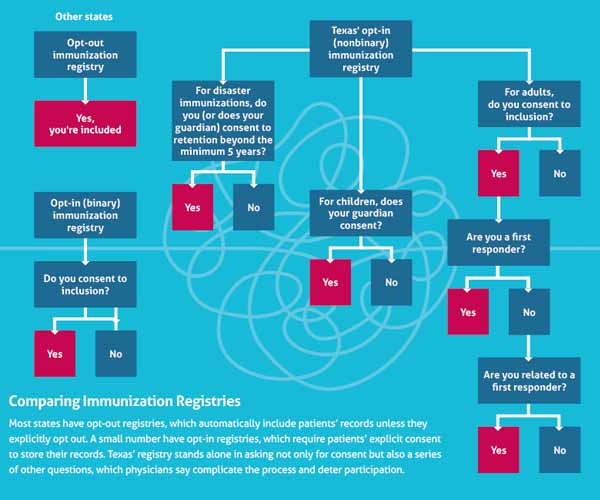
Dallas pediatrician Joseph Schneider, MD, always strives to keep his patients up to date with recommended vaccinations, of which there are dozens between birth and age 18.
That entails querying patients’ immunization record in ImmTrac2, the statewide registry, ahead of appointments. Consenting Texans have their records stored, allowing physicians, health departments, schools, and other relevant entities to see which shots patients have received.
Although such registries are intended to ease record-keeping, Texas’ unique “opt-in” law – which means patients’ vaccination status isn’t automatically included in ImmTrac2 – creates a labyrinth of difficulties. That’s especially true when it comes to interacting with electronic health records (EHRs), says Dr. Schneider, who also serves on the Texas Medical Association’s Committee on Health Information Technology.
“The more work required to get [immunization records] into ImmTrac, the more likely it will have omissions and not be up to date,” he said.
This has implications during a public health emergency, like the ongoing COVID-19 pandemic, when public health departments and other experts rely on registries to track immunization rates, assess community protection levels, and plan for an adequate supply of boosters.
TMA has been working to address these issues for years and is hopeful state lawmakers will be spurred by the ongoing pandemic to finally address ImmTrac2’s shortfalls during the upcoming legislative session, which begins in January. Improving the registry also dovetails with TMA’s other vaccine-related policy goals, including boosting childhood immunization rates, which have fallen during the pandemic, largely because of vaccine delinquency.
Nearly 16 million Texans – or roughly 55% of the state population – have consented to be included in the state registry, according to the Texas Department of State Health Services (DSHS). Most of those who have withheld consent are adults. In 2020, 80% of Texas children under 6 years old had at least two immunizations recorded, compared with 94% of children nationally, according to the Centers for Disease Control and Prevention. That same year, 4% of Texas adults aged 19 or older had at least one immunization recorded, compared with 68% nationally.
In addition, nearly 2.4% of Texas students had at least one conscientious exemption on file during the 2020-21 school year, more than five times the rate in the 2011-12 school year, according to DSHS.
Web of consent
All but five states have opt-out registries, which automatically store patients’ immunization records unless they explicitly withdraw, according to the American Immunization Registry Association.
Unlike the four other states with opt-in registries, however, Texas doesn’t simply ask for explicit consent to be included in the registry. Instead, it has three different forms and six consent types, according to DSHS.
There are forms for children and adults, plus one for disasters. And the adult version has additional consent types for first responders and their relatives. Adults between the ages of 18 and 25 also can consent to the retention of their childhood immunization records before they are deleted.

Dr. Schneider says the plethora of consent types can make it difficult for EHRs – which are typically designed with binary opt-in or opt-out registries in mind – to share information with ImmTrac2 and vice versa. As a result, practice staff must spend valuable time consulting ImmTrac2, checking it against their own records, and accounting for possible gaps.
“If it’s a lot of work [to query the registry] or if I’m very busy, both of which are generally true, then … I’m going to rely on the [parent’s] records,” he said. “I might rely on my records. I might rely upon mom’s memory.”
Although DSHS declared ImmTrac2 ready for bidirectional communication with EHRs in January 2021, TMA experts say many EHRs require customization to accommodate Texas’ six consent types, which EHR vendors don’t always provide.
Dr. Schneider likens the state law to a hypothetical requirement that cars have six headlights instead of the normal two. Some manufacturers might adapt their models, but most would shift their focus to the other 49 states where they could sell their wares as is.
As a result, many EHRs are incompatible with ImmTrac2, frustrating physicians and leading to lower participation rates.
“For ImmTrac to be all that it can be, Texas’ best bet is to get as close to national standards as possible,” he said.
In an email to Texas Medicine, Lara Anton, DSHS senior press officer, said more than 8,000 practices are submitting data successfully between their EHR and ImmTrac2. Although TMA staff say it is difficult to arrive at a precise number, the latest data from the U.S. Bureau of Labor Statistics suggest this represents approximately one-third of the privately owned practices in Texas.
Keller pediatrician Jason Terk, MD, says DSHS’ efforts have led to meaningful interoperability improvements for his practice.
“I don’t want to throw the baby out with the bathwater,” he said. “It’s better than it was in the past, but there’s still significant opportunities for improvement.”
Advocacy aims
TMA aims to revive the issue of ImmTrac2 reform going into the 2023 legislative session, and, as a blueprint, Dr. Schneider points to House Bill 4272 authored by state Rep. Stephanie Klick (R-Fort Worth) during the 2021 session.
Unfortunately, the bill did not survive, but it still holds promise and “would not only dramatically improve the functionality of the registry but also streamline current efforts to vaccinate as many Texans as possible in response to the COVID-19 pandemic,” Dr. Schneider wrote in testimony he delivered on behalf of TMA in support of the bill last year.
The proposed reforms would have:
- Made the consent option a binary yes-or-no question. Doing so would allow for easier interoperability between ImmTrac2 and EHRs, experts say.
- Eliminated the need for customization.
- Established an online portal through which to submit Imm-Trac2 withdrawal requests. Currently, patients who previously consented to be in the registry must request removal by fax or mail.
- Extended the retention period for disaster immunizations – including those that protect against COVID-19 – from five to seven years.
- Required DSHS to notify patients at least twice before deleting any disaster immunization records, providing them the chance to consent to their retention beyond that period. Currently, such records are retained for Texans who have consented to participate in the disaster immunization registry and are deleted after the five-year retention period for those who have not.
“The premature deletion of records of immunizations administered during a disaster interferes with identifying patients who may need a booster shot in the future,” according to the Texas Public Health Coalition.
Dr. Terk, who chairs the coalition, would prefer to see Texas shift to an opt-out system. But he says previously proposed reforms would go a long way to help Texas make the best of its opt-in system.
“Simplifying the consent process is great because it removes something that might provide inertia to go through a consenting process,” he said.
Dr. Terk and Dr. Schneider also proposed some additional policy changes, including:
- Hiding, rather than deleting, immunization records when a patient withdraws from ImmTrac2, which would allow records to be recovered if the patient later consents to be included in the registry; and
- Improving outreach to adults between the ages of 18 and 25, who must consent to the retention of their childhood immunization records before they turn 26.
Such changes would build on prior improvements to ImmTrac2 and make it a more functional registry.
Until then, however, “Texas will fall behind other states that have figured this out,” Dr. Schneider said.
Tex Med. 2022;118(7):42-44
Aug/Sept 2022
Texas Medicine Contents Texas Medicine Main Page